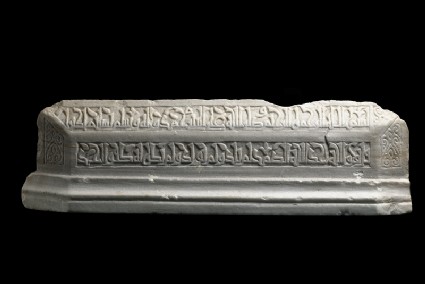Search Results: objects
Show search help- Reference URL
Actions
Tombstone of a Muslim girl
-
Description
This marble tombstone marked the burial of a Muslim woman, or more likely a young girl, who died in the 11th century. The shape of the tombstone, its material, and the style of writing used for the inscription suggest that it comes from North Africa, probably from present-day Tunisia.
The inscription running on both sides gives us information about name of the deceased and the date of her death. Although her name cannot be reconstructed with absolute certainty, she might have been called Ghariba, the daughter of Makhluf al-Jala. She died on 4 Shawwal of the year 431 of the Islamic calendar, corresponding to 17 June 1040 AD.
The identification of the deceased is preceded by blessings, and sura (chapter) 112 of the Qur’an, which proclaims the unique nature of God. The text ends with a prayer for the consolation of the deceased’s parents, which is often part of the inscriptions on the tombs of young children.
-
Details
- Associated place
-
Africa › North Africa (place of creation)
- Date
- 17 June AD 1040 (4 Shawwal AH 431)
- Associated people
-
Ghariba Bint Makhluq al-Jala (died AD 1040) (named on object)
- Material and technique
- marble, with carved decoration
- Dimensions
- 22 x 76 x 13 cm approx. (height x width x depth)
- Material index
- Technique index
- Object type index
- No. of items
- 1
- Credit line
- Purchased, 2006.
- Accession no.
- EA2006.21
-
Further reading
Musée du Petit Palais de la ville de Paris, 20 octobre 1982-19 février 1983, De Carthage à Kairouan: 2000 ans d'art et d'histoire en Tunisie [= From Carthage to Kairouan: 2000 Years of Art and History in Tunisia], Muhammad Fantar, ed. (Paris: Association française d'action artistique, 1982)
Location
Objects are sometimes moved to a different location. Our object location data is usually updated on a monthly basis. Contact the Jameel Study Centre if you are planning to visit the museum to see a particular object on display, or would like to arrange an appointment to see an object in our reserve collections.
Galleries
© 2013 University of Oxford - Ashmolean Museum










